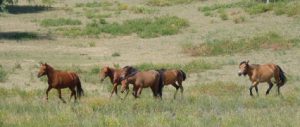At the Kalamaili Ungulate Nature Reserve in Xinjiang, China’s westernmost region, a group of Mongolian wild ass, or khulan, warily survey the sparsely-vegetated Gobi Desert. Not far behind them runs a new railway and, underneath it, a tunnel to allow animals to cross the lines.
The khulan, which is afforded the highest level of state protection in China, is the main reason this reserve exists. Seven hundred of them live here. In summer, they move to the lush green grasses of the mountains in the north and, in winter, return to the warmer Gobi. But in 2010 the railway – built to transport coal – cut a line from east to west across the reserve, leaving 160 animals trapped in the south.
Although passageways have been provided, the Khulan are not used to tunnels. The two populations have effectively been separated, raising concerns about the species’ breeding patterns and its ability to continue the migration it has been making for millions of years.
This is not the first time this 18,000-square kilometre reserve, which was founded in 1982, has been fragmented. In 1986, National Highway 216 arrived, cutting north to south through the heart of the reserve and isolating the Gobi’s water resources. Since then, animals have been forced to cross the road to reach water and are frequently hit by passing vehicles.
At the turn of the century, deposits of oil, gas and coal were found in the Kalamaili area. The reserve was subsequently reduced in size by several thousand square kilometres, and the new railway built to transport the coal, further dividing the protected area. With the highway running north to south and the railway travelling east to west, the reserve is now in pieces.
It is not the only protected area to have met this fate.
The 78,000-square kilometre Lop Lake Camel Reserve in Xinjiang is facing a similar crisis. Huge oil reserves have been discovered here and a question mark now hangs over the land. A proposal to reduce the size of the reserve has been approved at expert hearings at the Ministry of Environmental Protection and submitted to the State Council, China’s highest administrative body.
Although the plan has not yet been given the final green light, the reserve has in effect already been sliced up. A highway has been constructed to facilitate potassium extraction and a railway is to be built to transport coal to the east. In the north of the protected area, 30 to 40 coal or iron-ore mines have continued to operate in the decades since the reserve was founded. With new coal pits still being dug, the northern part of the reserve exists only in name.
Fan Zhiyong, formerly head of the office of the State Forestry Administration in charge of the import and export of endangered animals, is now director of WWF China‘s species programme. He said that China’s nature reserves “are facing a full-scale crisis”. Fan explained that there have been frequent changes in the size or use of protected areas in recent years, largely because the reserves have been forced to make way for local economic development. “Hydropower dams and fenced-off highways have cut off routes for migration and genetic exchange for many rare animals,” said Fan. “Habitats have been broken up and populations isolated.”
One conservation expert, who asked not to be named, said such protected areas have gradually been eroded: “Ten years ago, the problems were mostly internal – between the reserves and the people who lived on them. Now the reserves and the locals are both facing external pressures.”
The most distressing aspect, he said, is that it is local governments that are doing the damage. “As economies have developed, local governments have come to see reserves as a way to get rich – opening scenic and tourist areas up in order to sell tickets, and using the idea of GDP to evaluate and develop reserves.”
He explained that the world’s well-managed protected areas do not necessarily ban activities such as tourism, but instead combine low-cost entrance tickets with high-cost services to control visitor numbers. But when Chinese reserves develop tourism, the managers just think about ticket sales and run them poorly.
An investigation by the Chinese National Committee for Man and the Biosphere (part of the MAB Programme at UNESCO) found that 22% of China’s reserves have been damaged by ecotourism.
Xi Zhinong, wildlife photographer and founder of Wild China Film, believes China’s policy on nature reserves has major failings. The Law on the Protection of Wildlife explicitly encourages the rearing, breeding and “rational use” of wildlife – providing a legal cloak for actions against the spirit of the law. “Many rearing centres are actually illegally trading animals,” he said.
An official from Xinjiang’s Environmental Protection Bureau said that, when the Lop Lake reserve was first designated, the area was uninhabited – and as a result, an excessively large area was set aside for protection. The management office doesn’t have enough staff to cover the entire reserve, and the mines that have been set up here are all extracting strategic resources that the state is in dire need of.
“It really is too big – 78,000 square kilometres for 500 camels,” the official said. “We are preparing to make their feeding and watering grounds key protection areas, while zoning off the north of the reserve for producing coal to be sent east. That will also improve living standards for local people.”
Wang Ning, director of the Economics Institute at Xinjiang Academy of Social Sciences said: “Xinjiang is not like the interior of China – only 5% of our land is green and fertile, and that’s all the people have to live on. The animals get all the rest. Why not let the people develop some of that 95%? Denying development for the sake of animal protection is a kind of negative protection. We want to advocate a more positive approach, basing better protection on that development.”
Fan Zhiyong disagrees with this approach: “Setting up a nature reserve isn’t just about animal protection – the entire reserve should be protected and cleaned-up and allowed to recover. Resource exploitation doesn’t mean you have to take land from reserves. In many parts of the world, if you want to use reserve land, then you have to restore another parcel of land in exchange, so that the overall area remains constant.”
Fan sees the correct role of nature reserves as protecting and managing land on behalf of the state. But, under current arrangements, they take their orders from local government rather than acting on behalf of the nation.
In the United States, the Department of the Interior directly manages national parks, forests, nature reserves, Indian reservations and public coastline. These areas are of public interest and are centrally managed by the federal government – nobody can change the boundaries, or the uses to which the land is put. But under the Chinese system, reserves are not recognised as having the same level of public interest. Anyone can try to take land from a reserve, redraw the boundaries, or change the way the land is used.
“We urgently need to make it clear that this land is of public benefit and should be managed for the people as a whole by central government,” said Fan.
Sun Danping, formerly chief reporter at Beijing Youth Daily, is special environmental investigator at Global Village.
Homepage image by Li Weidong


